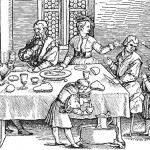Each week in The Moviegoer, Nick Olson examines new and upcoming films.
In Zack Snyder’s Man of Steel, the name “Superman” is only uttered once or twice, and when he wears the caped suit, it’s a muted–not blinding bright–red and blue. Some viewers will chalk up the details of Snyder’s (and Goyer’s and Nolan’s) reimagination to another instance of “going gritty”–and I suppose there’s something to that, particularly in the film’s controversial, climactic scene–but the mixture of grey to tone down those primary colors more notably has the effect of emphasizing moments when a beam of sunlight bathes the man of steel, washing over his face like a revelation. What in The Dark Knight Rises is a pivotal, culminating third act grace note–Batman fighting with the people in broad daylight–here in Man of Steel is a recurring, tone-setting origin point. Jor-El imagines the brightness of his Kryptonian son’s future greatness: “You will give the people an ideal to strive towards. They will race behind you, they will stumble, they will fall. But in time, they will join you in the sun. In time, you will help them accomplish wonders.”
It’s one of a few lines in the film meant to have gravitas–weighted with (cheaply?) intended Christological significance. The “ideal” (our latest Christ-figure even reads Plato!) that the people of earth will strive for is a goodness shaped distinctly by hope. The insignia on Superman’s chest is not an “S” back in Krypton, but a symbol that means “hope.” Giving decency an eschatological shape is–like some of the other Christological nods in the film–a nice sentiment, but it lacks touch. By the end of Man of Steel, it’s not only unclear what that hope is for beyond mere survival (I suppose Jor-el mentions hope for a better world, but like many such one-liners, it lacks support in the film), but it even remains questionable if Jor-El’s prophecy has been adequately fulfilled. Yes, of course, Superman saves the world and its people, but I’m not sure that an established disconnect between Superman and his adopted home planet of Earth ever reaches a meaningful moment in which a connection is established. Which is to say: Snyder’s Superman is often, with great effect, “a god to [us],” but rarely feels like a god with us. Yet, it’s not a total loss, because the former achievement provides consistent moments of genuine awesomeness.
Ultimately, this rebooted origin film tries to mix things up much like The Amazing Spider-Man in that achieving a more “serious” tone (which is these days so often conflated with “dark”) means creating an identity crisis for the protagonist. “Kal-El or Clark Kent?” is nearly as much of a crisis for Superman as General Zod barking marginally understandable insanities.
***
Man of Steel’s Superman story begins with labored cries on Krypton. Facing imminent extinction, the planet is in grave trouble, in part, because it has rid itself of natural birth in favor of mass artificial reproduction; human lives are now engineered for predetermined, streamlined purposes; these controls on natural freedoms have unforeseen consequences. In response to the looming destruction, two parties conceive of very different forms of rebellion. Jor-El and his wife Lara naturally have a child that may not be an immaculate conception, but, given the circumstances, is its own kind of miracle. Seeing that the end of their planet is coming, they launch their son–with the capabilities of free will and the codex to maintain the Kryptonian race–to planet earth. Meanwhile, General Zod wishes to undermine Krypton’s ruling council by force. And let’s just say that Zod, despite some level of respect for Jor-El, isn’t too happy that he’s lost access to the codex, which is essential to his own plan for preservation. The fallout involves murder, banishment to the Phantom Zone, and eventually planetary catastrophe.
Man of Steel is steeped in science fiction, which is conceptually effective, though at times fatiguing. It’s appealing in the sense that this dimension of the story makes for at least one sharp divergence from Nolan’s ultra-realism without sacrificing the (questionable) desire to preserve a sensibility of plausibility. To convey a sense of this effectiveness, I’d point to Clark Kent’s realization of his past as Kal-El from planet Krypton, and how he is able to meet his birth father, Jor-El, via an “illusion” brought to life by memory and consciousness. Which is to say: it’s a nice other-worldly contrast to the Kansas cornfields, providing a fully formed mythos that is, in itself, a response to “are we alone in the world.” The image of newborn Kal-El flying into space toward Earth with messianic potential, though not quite supernatural, is the type of subversion of a certain brand of realism that never satisfactorily comes in response to the Joker’s nihilism in Batman’s world (which is not at all to say that Man of Steel is on the whole more satisfactory than The Dark Knight Trilogy).
Yet, this sci-fi bent also becomes a bit tedious. At times, the lexical and visual jargon feels wearying instead of effectively facilitating strain-free immersion in an alternate world. Its sci-fi elements often seem overcomplicated, threatening to pollute, rather than complement, the pastoral simplicity of middle America. Which is to say: the sci-fi aspect of the film is sometimes too alien. Per my mention above, this is a complaint that’s not unrelated to the presentation of the film’s protagonist.
***
Newborn Kal-El makes it to earth and is adopted by Jonathan and Martha Kent, but, eventually–inevitably–General Zod comes looking for Jor-El’s son, the codex, and the possibility of reestablishing Krypton. One interesting, if superficial, contrast is that Zod ultimately wishes to fatally displace human beings on Earth in order to reestablish Krypton, while Clark Kent’s most significant struggle is to feel at home on Earth. One of my favorite moments during the film–and hopefully, like me, you didn’t have it spoiled by the TV spot which features it–is when Zod announces his impending invasion of earth by taking over all forms of media to deliver a message that, in the moment, is delightfully chilling. Shown broadcasting to places all over the world, it’s a successful introduction to the massive battle between Superman and Zod that’s coming, and works well in establishing what is, for me, the most admirable aspect of the film: its sense of scale.
Snyder’s film delivers on exhilaration–filled with the kind of moments that make you feel as if you’ve never seen anything like it on the big screen. In the moments when Superman positions himself to blast into the air, when he soars at top speed to tackle a foe through three or four buildings, when he holds up the structure of a burning, sinking tanker–all of it is awesome. There’s been much talk about the film’s attempt to get at the psychology of being Superman, but Man of Steel‘s real strength is the staggering way it captures the physiology of Superman. One critic best known for his eccentric–often head-scratching–contrarianism, Armond White, praised the film for the way it displays “the physics of stress.” It’s an apt phrase that probably best describes the successful way in which Superman’s raw power is both astonishing and, at least in this origin film, a burdensome weight on his earthly existence.
A common complaint against the film is that it’s overloaded with action. My concern is not with the film’s quality of action, but with its pacing. Again, the sense of scale to its action scenes is coherent–even artful. The problem, though, is that Man of Steel needs more scenes of calm–scenes with the sole purpose of building characterization (It’s quite disappointing that Amy Adams and Michael Shannon, in particular, aren’t given more to work with–Zod is little more than a pinched nerve.). Some of the early advertisements featured memory-like, beautiful scenes that had people name-dropping Terrence Malick. But these scenes, which work to convey back story, are too few and too abrupt. Any quiet moment is almost certainly a mere stand-in transition to the next explosive battle. The second act in particular is as developmentally unsteady as the film’s shaky-cam aesthetic.
The most essential problem with this second act (and I’m going to say *spoiler alert* from here on) is that the story’s focus on Superman-as-wanderer, or alien, while understandable and filled with potential in its attempt to capture a “what if?” realistic approach to the psychology of the situation, leads the film in its two most problematic–and controversial–directions. Steven Greydanus–probably my favorite critic to read when it comes to the genre–was the first to mention this, but my friend and I both gasped when, after a young Clark asks Pa Kent if he should have let the bus of kids die to protect the secret of his alien identity and powers, Pa Kent says “maybe.” Huh? This presumably unintended undermining of Clark Kent’s essential source of moral wisdom is not unrelated to the other controversial choice when, in the film’s climactic moment, Superman–meant to be conveyed, however questionably, as having limited options–snaps Zod’s neck to kill him. It’s the one moment in the film that especially fulfills the dreaded expectation that it would be too dark. But the reason it’s connected to Pa Kent’s flawed persistence to keep his son’s identity a secret is that in a recent interview Snyder says that he wanted the snap-neck moment to work as an origin explanation for why Superman doesn’t kill [in the future]–you know, that sensibility that doesn’t have to develop from the failure of having killed, but could instead originate from the positive reinforcement of a father who would only praise his son for saving a bus of children, no matter the potential fallout.
So the climactic, controversial snap-neck moment is a failure in the sense that it’s unclear in the moment what Snyder is going for. I don’t know how we’d have any sense that he was hoping to explain the reason that Superman doesn’t kill unless we read the interview in which he reveals it. That said, I think some heated reaction to the choice is overreaction. The moment is a weighted one tonally, even if we don’t have clear enough reasons as to why it was allowed to happen. Superman’s loud cry seems filled with regret, and in the very least, it seems to be a loaded identity moment given the film’s focus on his struggle to define who he is as Earth’s adopted son from Krypton. Killing Zod to protect particular human beings has at least the buildup of this identity crisis. And the moment–which has Superman in a position of deciding whether or not to act–seems to recall another pivotal moment in the film when his father has Clark refrain from saving his life in order to continue protecting the secret. Clark is made to watch his father die, and left to bear the weight of his own coerced inaction. The two moments have a complicated entanglement that suggest Snyder wasn’t just going for cool! violence in the controversial act, however much I think the direction a mistaken one.
***
My biggest problem with this Superman, though, is not his relationship with his father or the climactic kill (problematic as they are), but that he’s too steely in temperament. For a film that focuses so much on his secret identity and his plight as a wanderer, there’s never a significant reveal moment that connects Superman with the people in any relatable way. Save for his relationship with his mother, Superman come to earth is still too often, ironically, a distant god. Perhaps the film’s emphasis on “the secret” was another Christological call-up of Jesus’ insistence that his disciples keep-it-secret, but even so, Jesus wasn’t cold or distant from the people. Given that two of Superman’s most significant human connections–Lois and the newspaper business–are saved until the very end, it’s possible that the Man of Steel who is well adjusted to Earth as his home is coming in the sequel, but by the end of this first-act film, Superman doesn’t quite seem established, and that’s a problem. I’m not sure that he can be a guiding light of hope for the people if this connection of humanity isn’t yet adequately established.
Almost certainly one of the first steps to an eventual Justice League film to rival The Avengers, Man of Steel is nothing if not a marvel to see–even if it sometimes has more of an effect of straining the eyes than lighting the path forward.











